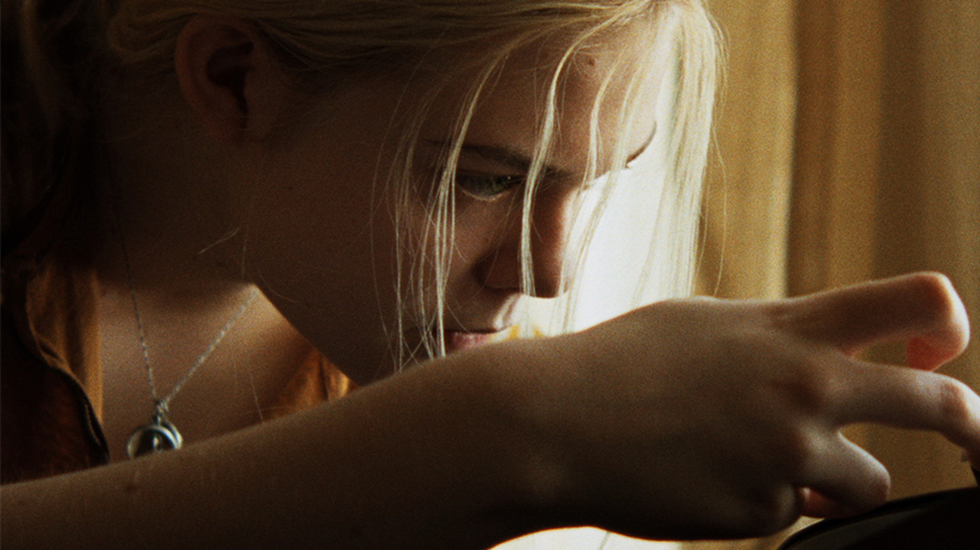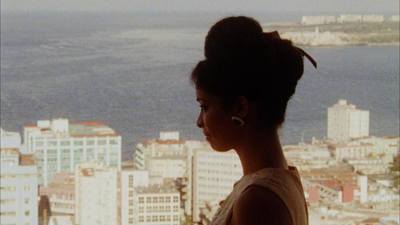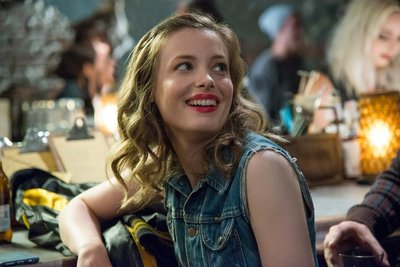
BY ZACHARY WIGON |
Jeff Preiss On The Connections Between Jazz And Cinema In 'Low Down'
Jeff Preiss on jazz and cinema, John Hawkes, and his decision to shoot 16mm.

An enormous advocation for still shooting film, Jeff Preiss's Low Down is one of the more beautiful-looking films you'll see this year, if not the most beautiful. Shot on 16mm, the low-contrast, milky-blacks images have a sensuous immediacy that highlights the formal beauty inherent in the cinematic medium, and which, appropriately, links the technical aspects of cinema with the formal qualities of another art form: jazz. Based on the memoir of Amy Jo Albany, Low Down concerns the relationship between the young Amy Jo (Elle Fanning) and her father, the accomplished jazz pianist Joe Albany (John Hawkes), who played with Charlie Parker, among other jazz luminaries.
An intimate character study that uses its formal conceits to probe and provoke an emotional response, the film feels like a cinematic equivalent of jazz, with its technical prowess utilized in the service of depicting a moving story about a father dealing with his drug and money problems while simultaneously trying to raise his daughter by himself. A Sundance 2014 premiere, the film will be released by Oscilloscope on Friday, October 24th. I recently spoke with Preiss via phone about the project.
Jazz is principally about a devotion to a form, to give a musician a kind of freedom based on a kind of virtuosity that comes from practicing a lot.
Tribeca Film: How did you become attracted to the material?
Jeff Preiss: I was a fan of Joe's music, and I met Amy before she wrote her memoir. She was working on my crew, doing craft services on a shoot. I went over to get a sandwich from her, and she seemed to have a story. She was listening to Chet Baker on a boom box while she was working, and I wondered if she was a Chet Baker fan. I'd known Chet Baker, so I said something like, this is a great record, and she said yeah, it is, and I said, I knew Chet Baker very well, and she said, what difference does that make, I knew him too, something like that. So I said, how did you know him? She said that her father had played with him. She was hesitant to name her father, because it kind of haunts her that Joe is so little known, but she said her father was Joe Albany, and I told her I loved her father's music, and then said, I hope I wasn't rude, I just never expect anyone to have heard of him.
So we started talking and these stories came out, and I had an idea to make a film with Amy, which was the first version of Low Down, I was going to ride around in LA to different sites she had stories about, and she would tell the stories and I would shoot landscapes of how these areas changed. But Amy was so shy that she couldn't speak the stories, so she started to write them, and her memoir came from that. The memoir was published, and Albert Berger and Ron Yerxa optioned it and tried to attach a director. And the project ended up coming back to me.
Tribeca Film: Are there connections between the form of jazz music and the formal approach you took to making Low Down?
Jeff Preiss: Very much so. I come out of all kinds of filmmaking practices, but reaching far back, I make experimental films, films that are lyrical, non-narrative first-person films. One of the reasons I never tried to make Low Down, before Ron and Albert came to me, was that if I was to make it, it might be too personal to suit the tastes of the market. But I really did want to use jazz music as a model, improvised music as a model, but everyone seems to think that means the film will be choppy or made up as you go along. I don't see that as the model of jazz at all. Jazz is principally about a devotion to a form, to give a musician a kind of freedom based on a kind of virtuosity that comes from practicing a lot.
I thought, to really use jazz as a model, we ended up having a film where the filmmakers are responding to the narrative in the moment we're filming it, but we're also really grounded in a discipline about filming. I've had a long career as a DP, and I shoot film virtually every day, so I wanted to bring formal perfectionism to the movie, as opposed to a looseness that people sometimes associate with jazziness.
When they walk and speak, they're expressing themselves in a way that is so at one with what their music is.
Tribeca Film: The film opens with a striking sequence that combines voice-over narration with freeze frames that stop and start with the voice-over. How did you conceive of that sequence?
JP: That's a great question. Another thing about virtuosity is, it's not good if it's cold - it works if it's a portal to expressing oneself, to expressing your personhood. The music is so emotional. That voice-over comes directly from the book, we're channeling Amy's inner thoughts. The jazz model works the best when the person has something authentic in them, which makes them living music. That's the idea Amy had of her dad - her dad was kind of like living music, and I know that this is true of great jazz musicians. When they walk and speak, they're expressing themselves in a way that is so at one with what their music is. Also, Joe's music - you hear the consequence of the trouble he suffered in it. His successes and his failures.
Tribeca Film: How did you decide to use freeze frames against that voice-over?
JP: Voice-over is a very mysterious thing, because films are always happening in real time, and then the voice is coming at the same real time, but it's not happening at the same real time - it's coming from the future, looking back. So I thought a freeze frame would help with the effect of the voice coming from a different time from what you're seeing. I love the idea of freezing this moment, Joe's literally in midair, suspending that in an image.
I learned from [John Hawkes] about asking more than what you think is possible from yourself.
Tribeca Film: You talk about a musician kind of living jazz, and it's so apparent that that's in John Hawkes's performance. How did you prep with him?
JP: John bought himself jazz for the role. He's supremely disciplined and has very high standards for the work he's going to do. I learned from him about asking more than what you think is possible from yourself. He's not a pianist, but he learned how to play piano, and he's enacting Joe's piano solos in the film. It's a superhuman accomplishment of acting. He did somehow channel Joe Albany. Amy, looking at the film, said that she saw things onscreen that were invisible to her when he was performing on set, but she said they were so totally her father. Everyone was in awe of how he was able to inhabit Joe. But there's no explaining how he did it, unless you want to say magic!
Tribeca Film: Before you directed this film, you did much work as a DP, and the film has a really striking aesthetic. What was your process like of developing the look of the film with your DP?
JP: Being very particular about DPs, I knew that I would have to feel very close to the DP for the film, which was scary, because I didn't know if it would be possible to find the right person. I knew I loved Chris Blauvelt's work, and it was just a matter of meeting him, but we met over Skype, and immediately I knew he was exactly who I wanted to work with - he's so honest. Also, I knew it was absolutely necessary to shoot on film. I knew this would be questioned, because there's a financial consequence to shooting on film, so I made up a reason that I knew was true, which was that this was a period piece, and so shooting on film would help it look period. That's true, but that's not really the reason - the reason was something I can't explain, and it would be a losing cause to try. It's the mystery of why film feels different. Also, I wanted to shoot 16mm, not 35mm, because I wanted to push the awareness of it being film.
Finally, we decided to shot anamorphically, not with spherical lenses. With spherical lenses, you are cropping the image to get the aspect ratio. With anamorphic lenses you are optically stretching the image to get the aspect ratio. So with anamorphic your eyes move from left to right, scanning, and it organizes the space in such a beautiful way. And we looked at movies from the 70s, because we wanted it to look like the 70s. The real breakthrough films, to me, are the cinema verite films - Pennebaker, Maysles, and so on. We wanted to channel that, although I didn't want it to feel like a documentary, but I wanted it to have documentary immediacy.

